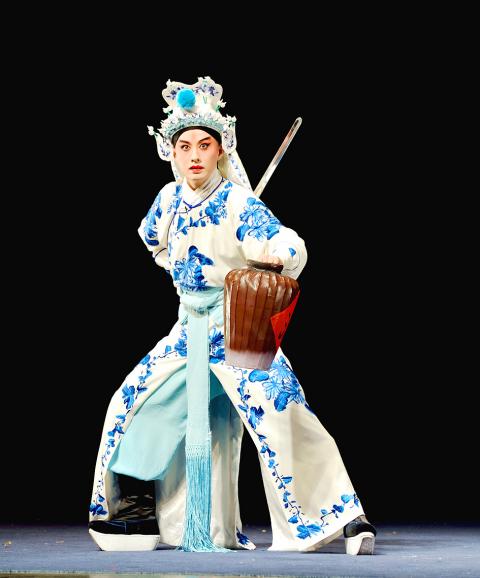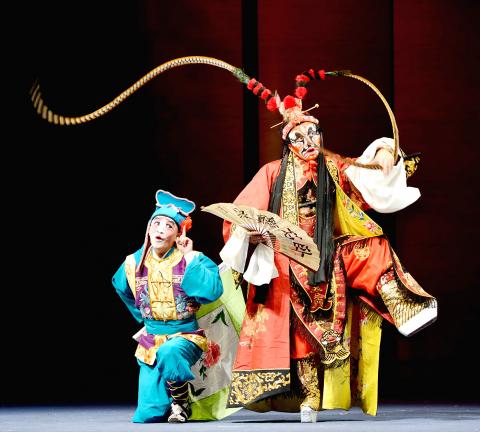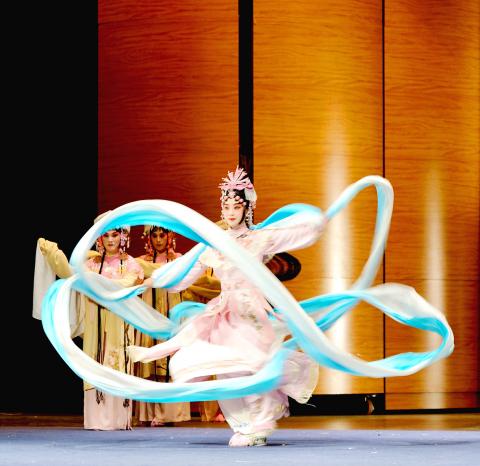Kunqu has come a long way over the last decade and it might be argued that a very considerable amount of credit for this must go to Kenneth Pai (白先勇), author and self-proclaimed servant of kunqu. Pai has created “youth versions” (青春版) of two major kun operas that introduced young stars, sumptuous costumes, and his own influential imprimatur to create productions that showed kun opera was not only beautiful, but also exciting and romantic.
In 2004, Pai premiered his production of the Peony Pavilion (牡丹亭), which proved a massive hit, the young and relatively inexperienced performers benefiting from training by some of the biggest names in kun opera, and the look of the show drawing on the talents of top fashion, lighting and set designers. Tomorrow sees the Taiwan premiere of Nanke Dream (南柯夢), a production based on a similar format, starring the top young talent from the Jiangsu Province Kun Opera Theater (江蘇省演藝集團) and directed by Wang Chia-ming (王嘉明), an award-winning Taiwanese director.
Nanke Dream, sometimes translated as A Dream Under the Southern Bough, is one of four operas written by Tang Xianzu (湯顯祖), which are collectively referred to as “the four dreams” (臨川四夢) because of the important role that dreams play.

Photo Courtesy of NTCH
All four operas are highly regarded works, but the technical complexity of staging Nanke Dream has caused it to be largely ignored by producers for more than a century. National Theater and Concert Hall artistic director Huang Pi-twan (黃碧端) said that the current production was important to make good this gap in the presentation of Tang’s work. She also underlined the fact that the work had considerable importance as a likely inspiration for the great Chinese classic novel Dream of the Red Chamber (紅樓夢), and was therefore an important link in Chinese literary and theatrical tradition.
The full opera of Nanke Dream runs to 44 acts and was intended to be performed over many days. The opera has been condensed to 15 acts to be performed in six hours over two nights. Musical director Sun Jianan (孫建安), who was responsible for collating available literati and scores of the opera, emphasized the complexity of the task of condensing such a complex work. “A kun opera is like a symphony, it has structural integrity. In cutting the opera down to a manageable size it was important that this structure remained intact,” he said.
Considerable effort has been made to present the opera in as authentic a manner as possible, so the choice of Wang, a director better known for his award-winning contemporary work, was unusual, even controversial.

Photo Courtesy of NTCH
Huang Hsiao-wei (黃曉薇), chairman of the Chien Kuo Foundation for Arts and Culture (建國工程文化藝術基金會), which is financing the production, said that many kun aficionados would probably be worried by this unconventional choice. She added that the century-long lapse in production of this opera meant that many aspects of the show had to be created from scratch.
Speaking about his first involvement in classical theater, Wang said: “ Kun opera has a very comprehensive theatrical vocabulary. It already has a high degree of expressive subtlety. I felt no need to replace this with any modern concepts or somehow reinterpret tradition through a contemporary perspective. Traditional and modern art are not polarized. What fascinated me was to see how this opera was so avant-garde at the time it was written. This is particularly what I want to emphasize, as we often forget that classic works were at one time challenging the establishment.”
Working within a classical model but finding room for creativity is something that pervades all aspects of the production. Lai Hsuan-wu (賴宣吾), who designed the costumes for Tsui Hark’s (徐克) film Flying Swords of Dragon Gate (龍門飛甲), has created a sumptuous collection of costumes that look traditional at first glance, but the pictorial motifs and styles of embroidery are the designer’s own.

Photo Courtesy of NTCH
Another aspect of Nanke Dream that should be emphasized is the large number of “hualien” (花臉) character types in the performance. The “hualien” is a specialist character who has some affinity to the clown in requiring highly exaggerated and sometimes acrobatic movements and expressions. The Jiangsu Province Kun Opera Theater is one of the very few kun opera companies that has the depth of talent to field such a line up, a result of the investment of time and money that kun has obtained as a result of its growing visibility on the traditional arts scene.
The story of Nanke Dream is well known. An unsuccessful scholar takes a nap under a tree and has a dream. In the dream he enters an imaginary kingdom where he becomes involved in court politics, rises to high position, marries a princess, and finally, after a life full of incident, is devastated when his wife dies. He takes up a dissolute lifestyle and is exiled by the king, but eventually wakes to discover that the kingdom he imagined himself in was no more than the ant colony on which he slept. The opera is heavily informed by Buddhist ideas of the emptiness of being, while the performance itself, with its delightful characters and subtle characterization, is clearly utterly in love with being.

Following the shock complete failure of all the recall votes against Chinese Nationalist Party (KMT) lawmakers on July 26, pan-blue supporters and the Chinese Communist Party (CCP) were giddy with victory. A notable exception was KMT Chairman Eric Chu (朱立倫), who knew better. At a press conference on July 29, he bowed deeply in gratitude to the voters and said the recalls were “not about which party won or lost, but were a great victory for the Taiwanese voters.” The entire recall process was a disaster for both the KMT and the Democratic Progressive Party (DPP). The only bright spot for

Water management is one of the most powerful forces shaping modern Taiwan’s landscapes and politics. Many of Taiwan’s township and county boundaries are defined by watersheds. The current course of the mighty Jhuoshuei River (濁水溪) was largely established by Japanese embankment building during the 1918-1923 period. Taoyuan is dotted with ponds constructed by settlers from China during the Qing period. Countless local civic actions have been driven by opposition to water projects. Last week something like 2,600mm of rain fell on southern Taiwan in seven days, peaking at over 2,800mm in Duona (多納) in Kaohsiung’s Maolin District (茂林), according to

Aug. 11 to Aug. 17 Those who never heard of architect Hsiu Tse-lan (修澤蘭) must have seen her work — on the reverse of the NT$100 bill is the Yangmingshan Zhongshan Hall (陽明山中山樓). Then-president Chiang Kai-shek (蔣介石) reportedly hand-picked her for the job and gave her just 13 months to complete it in time for the centennial of Republic of China founder Sun Yat-sen’s birth on Nov. 12, 1966. Another landmark project is Garden City (花園新城) in New Taipei City’s Sindian District (新店) — Taiwan’s first mountainside planned community, which Hsiu initiated in 1968. She was involved in every stage, from selecting

As last month dawned, the Democratic Progressive Party (DPP) was in a good position. The recall campaigns had strong momentum, polling showed many Chinese Nationalist Party (KMT) lawmakers at risk of recall and even the KMT was bracing for losing seats while facing a tsunami of voter fraud investigations. Polling pointed to some of the recalls being a lock for victory. Though in most districts the majority was against recalling their lawmaker, among voters “definitely” planning to vote, there were double-digit margins in favor of recall in at least five districts, with three districts near or above 20 percent in